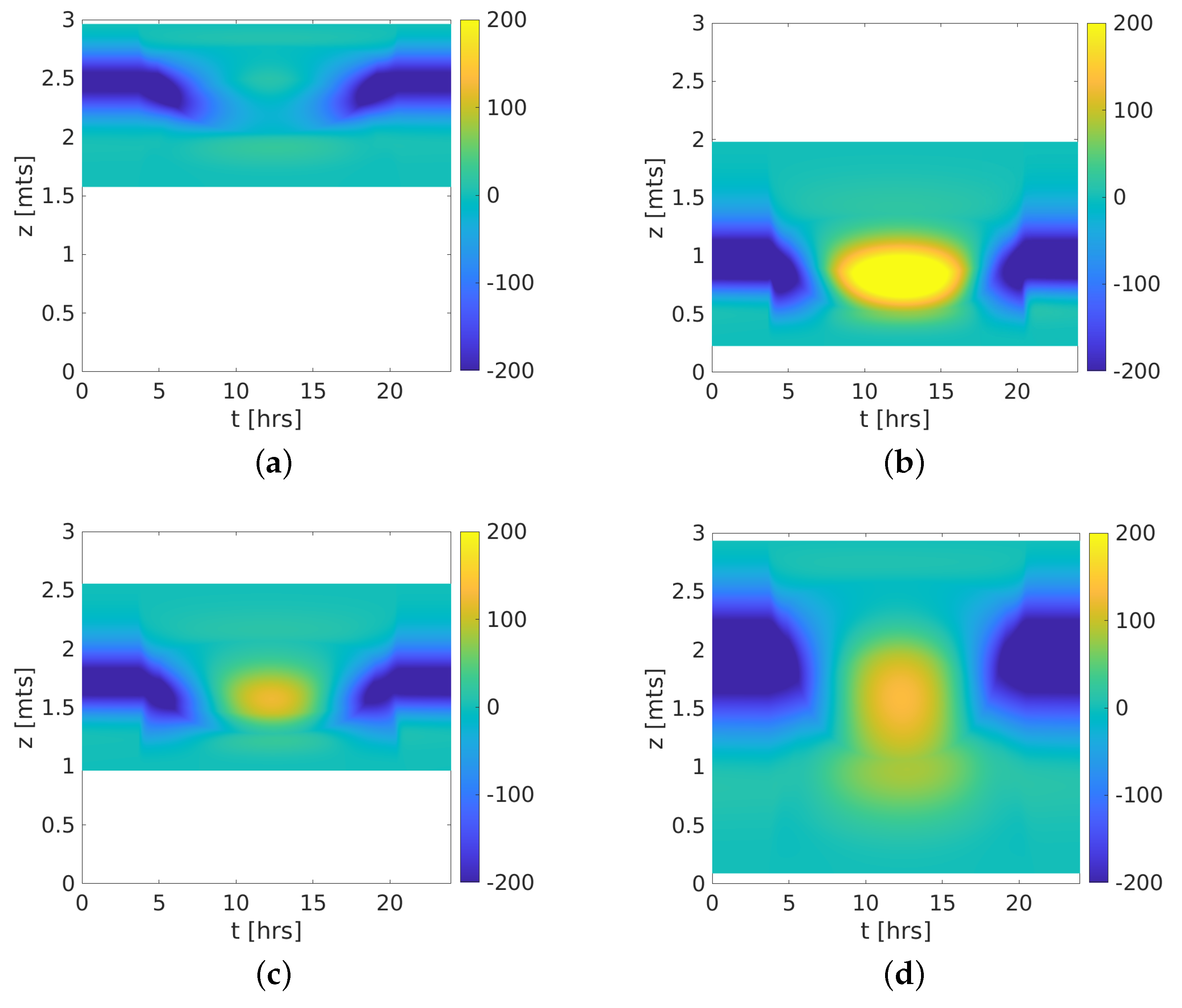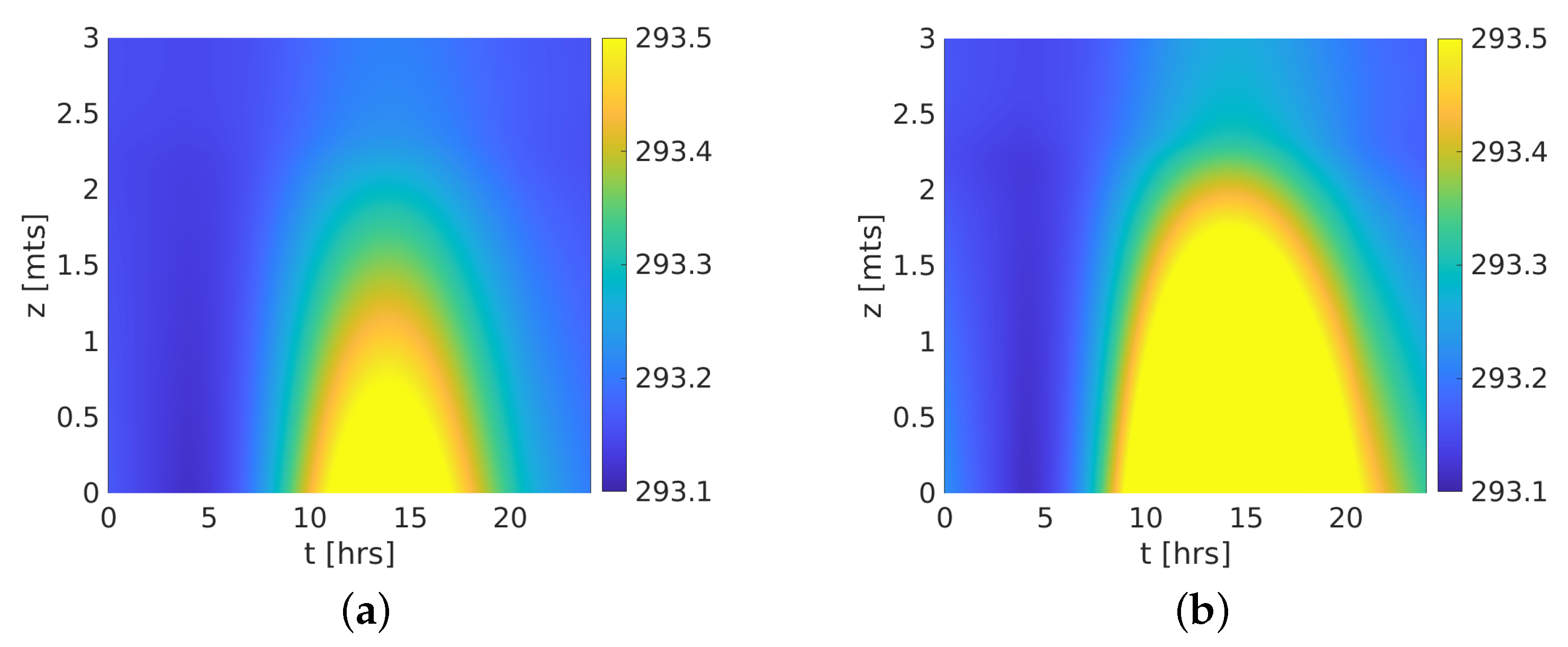Simulation of Heat and Water Transport on Different Tree Canopies: A Finite Element Approach
Abstract
:1. Introduction
2. Materials and Methods
2.1. The Mathematical Model
2.2. The Weibull Distribution and Canopy Shape Characterization
2.3. Initial and Boundary Conditions
2.4. Numerical Solution
2.4.1. Finite Element Approach
2.4.2. Time Discretization and Relaxed Fixed Point Scheme
2.5. Mesh Configuration, Adjustments, and Sensible Analysis
3. Results
Numerical Experiments, Comparative between Different Artificial Canopies
4. Discussions
Author Contributions
Funding
Acknowledgments
Conflicts of Interest
Appendix A. A Multi-Layer Model to Estimate the Radiation Extinction through the Canopy
Appendix B. Computing Contributions Matrices of the Gradients of El and Hl
Appendix C. Nomenclature and Values of the SHAW-derived Model Parameters
| Symbol/Value | Definition | Symbol/Value | Definition |
|---|---|---|---|
| = 24 h | Simulation time | vaporization enthalpy | |
| specific heat air | soil conductivity | ||
| specific heat foliage | latitude | ||
| specific heat soil | zero level displacemet | ||
| characteristic leaf length | soil level displacement | ||
| day number of the year | foliage transitivity | ||
| air column height | pile leaves factor | ||
| canopy height | air transitivity | ||
| soil layer width | canopy biomass | ||
| soil albedo | mean leaf width | ||
| foliage vertical profile | air density | ||
| leaf albedo | total LAI | ||
| canopy emissivity | stomata resistance | ||
| soil emissivity | sky temperature | ||
| reference velocity | air reference temperature | ||
| reference height | initial air temperature | ||
| soil reference height | initial leaf temperature | ||
| soil convection roughness | reference soil temperature | ||
| mesh elements in air | initial soil temperature | ||
| mesh elements in canopy | soil thermal conductivity | ||
| mesh elements in soil | time step | ||
| mesh elements in trunk | air reference humidity | ||
| minimum canopy radiation | initial humidity | ||
| minimum stomata temperature |
References
- Bonan, G.B.; Patton, E.G.; Finnigan, J.J.; Baldocchi, D.D.; Harman, I.N. Moving beyond the incorrect but useful paradigm: Reevaluating big-leaf and multilayer plant canopies to model biosphere-atmosphere fluxes—A review. Agric. For. Meteorol. 2021, 306, 108435. [Google Scholar] [CrossRef]
- Yun, S.H.; Park, C.Y.; Kim, E.S.; Lee, D.K. A Multi-Layer Model for Transpiration of Urban Trees Considering Vertical Structure. Forests 2020, 11, 1164. [Google Scholar] [CrossRef]
- Dargahi, M.; Newson, T.; Moore, J.R. A Numerical Approach to Estimate Natural Frequency of Trees with Variable Properties. Forests 2020, 11, 915. [Google Scholar] [CrossRef]
- Zhao, W.; Qualls, R.J. A multiple-layer canopy scattering model to simulate shortwave radiation distribution within a homogeneous plant canopy. Water Resour. Res. 2005, 41. [Google Scholar] [CrossRef]
- Wu, C.; Chau, K.; Huang, J. Modelling coupled water and heat transport in a soil–mulch–plant–atmosphere continuum (SMPAC) system. Appl. Math. Model. 2007, 31, 152–169. [Google Scholar] [CrossRef] [Green Version]
- Banimahd, S.; Zand-Parsa, S. Simulation of evaporation, coupled liquid water, water vapor and heat transport through the soil medium. Agric. Water Manag. 2013, 130, 168–177. [Google Scholar] [CrossRef]
- Flerchinger, G.; Pierson, F. Modeling plant canopy effects on variability of soil temperature and water. Agric. For. Meteorol. 1991, 56, 227–246. [Google Scholar] [CrossRef]
- Flerchinger, G.N.; Kustas, W.P.; Weltz, M.A. Simulating Surface Energy Fluxes and Radiometric Surface Temperatures for Two Arid Vegetation Communities Using the SHAW Model. J. Appl. Meteorol. 1998, 37, 449–460. [Google Scholar] [CrossRef] [Green Version]
- Flerchinger, G.; Yu, Q. Simplified expressions for radiation scattering in canopies with ellipsoidal leaf angle distributions. Agric. For. Meteorol. 2007, 144, 230–235. [Google Scholar] [CrossRef]
- Flerchinger, G.; Xiao, W.; Sauer, T.; Yu, Q. Simulation of within-canopy radiation exchange. NJAS-Wagening. J. Life Sci. 2009, 57, 5–15. [Google Scholar] [CrossRef] [Green Version]
- Flerchinger, G.N.; Reba, M.L.; Link, T.E.; Marks, D. Modeling temperature and humidity profiles within forest canopies. Agric. For. Meteorol. 2015, 213, 251–262. [Google Scholar] [CrossRef]
- Coops, N.C.; Smith, M.L.; Jacobsen, K.L.; Martin, M.; Ollinger, S. Estimation of plant and leaf area index using three techniques in a mature native eucalypt canopy. Austral Ecol. 2004, 29, 332–341. [Google Scholar] [CrossRef]
- Mori, S.; Hagihara, A. Crown profile of foliage area characterized with the Weibull distribution in a hinoki (Chamaecyparis obtusa) stand. Trees 1991, 5, 1432–2285. [Google Scholar] [CrossRef]
- Launiainen, S.; Katul, G.G.; Lauren, A.; Kolari, P. Coupling boreal forest CO2, H2O and energy flows by a vertically structured forest canopy–Soil model with separate bryophyte layer. Ecol. Model. 2015, 312, 385–405. [Google Scholar] [CrossRef]
- Campbell, G.S.; Norman, J. An Introduction to Environmental Biophysics; Springer Science + Business Media: New York, NY, USA, 1988. [Google Scholar] [CrossRef]
- Flerchinger, G.N.; Reba, M.L.; Marks, D. Measurement of Surface Energy Fluxes from Two Rangeland Sites and Comparison with a Multilayer Canopy Model. J. Hydrometeorol. 2012, 13, 1038–1051. [Google Scholar] [CrossRef]
- Absi, R. Reinvestigating the Parabolic-Shaped Eddy Viscosity Profile for Free Surface Flows. Hydrology 2021, 8, 126. [Google Scholar] [CrossRef]
- Harman, I.N.; Finnigan, J.J. Scalar Concentration Profiles in the Canopy and Roughness Sublayer. Bound.-Layer Meteorol. 2008, 129, 323–351. [Google Scholar] [CrossRef]
- Liu, R.; Huang, W.; Ren, H.; Yang, G.; Wang, J.; Li, X. Research on FPAR vertical distribution in different variety maize canopy. In Proceedings of the 2011 IEEE International Geoscience and Remote Sensing Symposium, Vancouver, BC, Canada, 24–29 July 2011; pp. 2745–2748. [Google Scholar] [CrossRef]
- Lazzari, L. 8-Statistical Analysis of Corrosion Data. In Engineering Tools for Corrosion; Lazzari, L., Ed.; European Federation of Corrosion (EFC) Series; Woodhead Publishing: Kidlington, UK, 2017; pp. 131–148. [Google Scholar] [CrossRef]
- Yang, X.; Witcosky, J.J.; Miller, D.R. Vertical Overstory Canopy Architecture of Temperate Deciduous Hardwood Forests in the Eastern United States. For. Sci. 1999, 45, 349–358. [Google Scholar] [CrossRef]
- Coops, N.C.; Hilker, T.; Wulder, M.A.; St-Onge, B.; Siggins, A.; Trofymow, J.A. Estimating canopy structure of Douglas-fir forest stands from discrete-return LiDAR. Trees 1999, 21, 349–358. [Google Scholar] [CrossRef] [Green Version]
- Oleson, K.W.; Lawrence, D.M.; Bonan, G.B.; Flanner, M.G.; Kluzek, E.; Lawrence, P.J.; Levis, S.; Swenson, S.C.; Thornton, P.E.; Dai, A.; et al. Technical Description of Version 4.0 of the Community Land Model (CLM); Technical Report; National Center for Atmospheric Research: Boulder, CO, USA, 2010. [Google Scholar]
- Larson, M.G.; Bengzon, F. The Finite Element Method: Theory, Implementation, and Applications; Springer: Berlin/Heidelberg, Germany, 2013. [Google Scholar] [CrossRef]
- Reddy, J.N. An Introduction to Nonlinear Finite Element Analysis with Applications to Heat Transfer, Fluid Mechanics, and Solid Mechanics, 2nd ed.; Oxford University Press: Oxford, UK, 2014. [Google Scholar] [CrossRef]
- Nakamura, S. Applied Numerical Methods with Software; Prentice-Hall: Harlow, UK, 1991; ISBN 9780130410474. [Google Scholar]
- Hansen, F.V. Surface Roghness Lengths; Technical Report; U.S. Army Research Laboratory: Adelphi, MD, USA, 1994. [Google Scholar]
- SHAW Model: USDA ARS. 2021. Available online: https://www.ars.usda.gov/ARSUserFiles/20520500/SHAW/302/SHAWReferences.pdf’ (accessed on 4 February 2021).
- Iqbal, M. An Introduction to Solar Radiation; Academic Press Canada: Waterloo, ON, Canada, 1983. [Google Scholar] [CrossRef]
- Zhao, W.; Qualls, R.J. Modeling of long-wave and net radiation energy distribution within a homogeneous plant canopy via multiple scattering processes. Water Resour. Res. 2006, 42. [Google Scholar] [CrossRef] [Green Version]







| Case 1 (Top) | Case 2 (Low) | Case 3 (Middle) | Case 4 (Height-Wise) | |
|---|---|---|---|---|
| 0.25 | 0.75 | 0.5 | 0.5 | |
| 3.5 | 11.0 | 7.5 | 3.25 |
Publisher’s Note: MDPI stays neutral with regard to jurisdictional claims in published maps and institutional affiliations. |
© 2021 by the authors. Licensee MDPI, Basel, Switzerland. This article is an open access article distributed under the terms and conditions of the Creative Commons Attribution (CC BY) license (https://creativecommons.org/licenses/by/4.0/).
Share and Cite
Villarreal-Olavarrieta, C.E.; García-Chan, N.; Vázquez-Méndez, M.E. Simulation of Heat and Water Transport on Different Tree Canopies: A Finite Element Approach. Mathematics 2021, 9, 2431. https://doi.org/10.3390/math9192431
Villarreal-Olavarrieta CE, García-Chan N, Vázquez-Méndez ME. Simulation of Heat and Water Transport on Different Tree Canopies: A Finite Element Approach. Mathematics. 2021; 9(19):2431. https://doi.org/10.3390/math9192431
Chicago/Turabian StyleVillarreal-Olavarrieta, Carlos E., Néstor García-Chan, and Miguel E. Vázquez-Méndez. 2021. "Simulation of Heat and Water Transport on Different Tree Canopies: A Finite Element Approach" Mathematics 9, no. 19: 2431. https://doi.org/10.3390/math9192431
APA StyleVillarreal-Olavarrieta, C. E., García-Chan, N., & Vázquez-Méndez, M. E. (2021). Simulation of Heat and Water Transport on Different Tree Canopies: A Finite Element Approach. Mathematics, 9(19), 2431. https://doi.org/10.3390/math9192431






